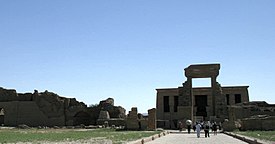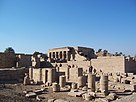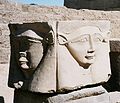Dendera
Dendera
ⲛⲓⲧⲛⲧⲱⲣⲉ ⲛⲓⲧⲉⲛⲧⲱⲣⲓ دندرة | |
|---|---|
Clockwise from top: Entrance to Dendara Temple, Dendara Temple Complex, Inside Hathor Temple, Hathor Temple Complex | |
| Coordinates: 26°10′05″N 32°39′22″E / 26.16806°N 32.65611°E | |
| Country | |
| Governorate | Qena |
| Time zone | UTC+2 (EST) |
Dendera (Arabic: دَنْدَرة Dandarah; Ancient Greek: Τεντυρις or Τεντυρα; Bohairic Coptic: ⲛⲓⲧⲉⲛⲧⲱⲣⲓ, romanized: Nitentōri; Sahidic Coptic: ⲛⲓⲧⲛⲧⲱⲣⲉ, romanized: Nitntōre),[1][2] also spelled Denderah, ancient Iunet 𓉺𓈖𓏏𓊖 “jwn.t”,[3] Tentyris[4][5],(Arabic: Ewan-t إيوان-ة ),[6] or Tentyra[7] is a small town and former bishopric in Egypt situated on the west bank of the Nile, about 5 kilometres (3 mi) south of Qena, on the opposite side of the river. It is located approximately 60 kilometres (37 mi) north of Luxor and remains a Latin Catholic titular see. It contains the Dendera Temple complex, one of the best-preserved temple sites from ancient Upper Egypt.
Etymology
[edit]
| ||||
| jwnt[8] in hieroglyphs | ||||
|---|---|---|---|---|
| Era: Old Kingdom (2686–2181 BC) | ||||
| ||||||||
| t3 n t3 rr(t)[1][9] in hieroglyphs | ||||||||
|---|---|---|---|---|---|---|---|---|
| Era: Ptolemaic dynasty (305–30 BC) | ||||||||


The original name of the town is Ancient Egyptian: ı͗wnt, the etymology of which is unknown. It was later complemented by the name of the chief goddess Hathor and became Egyptian Ancient Egyptian: ı͗wnt-tꜣ-ntrt, lit. 'ı͗wnt of the goddess' which is the source of Coptic: ⲛⲓⲧⲉⲛⲧⲱⲣⲓ, romanized: Nitentōri or just tꜣ-ntrt "of the goddess", which is the source of Koinē Greek: Τεντυρις. The modern Arabic name of the town comes from either its Greek or Coptic name.[10]
There is also an aberrant Coptic form ⲛⲓⲕⲉⲛⲧⲱⲣⲓ, which could be either dissimilation of a regular name or a confusion with Koine Κένταυροι.[11][12]
Temple complex
[edit]
The Dendera Temple complex, which contains the Temple of Hathor, is one of the best-preserved temples, if not the best-preserved one, in all of Upper Egypt. The whole complex covers some 40,000 square meters and is surrounded by a hefty mud brick wall. The present Temple of Hathor dates back to July 54 BC, at the time of Ptolemy XII of the Ptolemaic dynasty,[13] and was completed by the Roman emperor Tiberius, but it rests on the foundations of earlier buildings dating back at least as far as Khufu (known as the Great Pyramid builder Cheops, the second Pharaoh of the 4th dynasty [c. 2613–c. 2494 BC]) but it was the pharaoh Pepi I Meryre who built the temple.[13][14]
It was once home to the celebrated Dendera zodiac, which is now displayed in the Louvre Museum in Paris. There are also Roman and pharaonic Mammisi (birth houses), ruins of a Coptic church and a small chapel dedicated to Isis, dating to the Roman or the Ptolemaic epoch.
In the vicinity of the temple complex a bakery dated to the First Intermediate Period was discovered by the French-Polish expedition from the Institut français d’archéologie orientale (IFAO) and the Polish Centre of Mediterranean Archaeology, University of Warsaw. Bread offered to Hathor was baked here.[15] The team also excavated the so-called Eastern Temple in this area.[16]
The area around the temple has been extensively landscaped and now has a modern visitor centre, bazaar and small cafeteria.
Ecclesiastical history
[edit]After Egypt became a Roman possession, the city of Tentyris was part of the Late Roman province of Thebais Secunda. Its bishopric was a suffragan of Ptolemais Hermiou, the capital and metropolitan see of the province. Little is known of the history of Christianity in the place, as only the names of two ancient bishops are given:
- Pachomius the Great, generally recognized as the founder of Christian cenobitic monasticism
- Serapion or Aprion, a contemporary and friend of the monk Pachomius, whose diocese boasted the celebrated convent of Tabenna.
The town was given its present Arabic name of Denderah during the late Ottoman Empire and ruled 6000 inhabitants in Qena (Qeneh) district.
Titular see
[edit]Under the Latin name Tentyris, the episcopal see was nominally revived as a titular bishopric (in Curiate Italian repeatedly renamed) since 1902, but is vacant since 1972,[17] having had the following incumbents of the fitting episcopal (lowest) rank :
- Matteo Gaughren, Missionary Oblates of Mary Immaculate (O.M.I.) (1902.01.13 – 1914.05.30)
- Emile-Marie Bunoz, O.M.I. (1917.06.13 – 1945.06.03)
- André van den Bronk, Society of African Missions (S.M.A.) (1946.07.30 – 1952.05.15)
- Teodoro Bensch (1956.12.01 – 1958.01.07)
- Jean-Rosière-Eugène Arnaud, Paris Foreign Missions Society (M.E.P.) (1958.03.02 – 1972.09.11).
Climate
[edit]This area has a large amount of sunshine year round due to its stable descending air and high pressure. According to the Köppen climate classification system, Dendera has a hot desert climate, abbreviated "BWh" on climate maps.[18]
Sponsors
[edit]-
Ptolemy XII before Hathor and Philae, at the Hathor Temple, Dendera, which he built in 54 BC.[13][19]
-
Roman Emperor Domitian on the Northern gate of the Temple of Hathor.
-
Roman Emperor Trajan at Dendera, Egypt
-
Roman Emperor Trajan offers to Hathor and Ra-Harakhte, Dendera.
-
Emperor Trajan as a Pharaoh making an offering to the Gods, in Dendera.[21]
Monuments
[edit]References – Notes
[edit]- ^ a b Gauthier, Henri (1929). Dictionnaire des Noms Géographiques Contenus dans les Textes Hiéroglyphiques Vol. 6. p. 23.
- ^ "Tentyris (Dendera)". Trismegistos. Retrieved 29 March 2020.
- ^ Philae-Data. "Iunet (Dendera)". ancientworlds.net. Archived from the original on 2008-05-17.
- ^ "Linguistic Bibliography". blonline.nl. Archived from the original on 2014-03-04.
- ^ "Félix Teynard - Dendérah (Tentyris), Temple d'Athôr - Face Postérieure - Cléopatre et Cæsarion - The Metropolitan Museum of Art". metmuseum.org.
- ^ Hawas, Zahi (2002). مخطوط معجم اللغة المصرية القديمة احمد كمال كمال. الجزء االثاني عشر (in Arabic). Cairo: Al-maǧlis al-aʿlá li-l-aṯār, high council of antiquities. p. 496. ISBN 9773053474.
- ^ In old sources such as Belzoni.
- ^ Gauthier, Henri (1925). Dictionnaire des Noms Géographiques Contenus dans les Textes Hiéroglyphiques Vol. 1. p. 56.
- ^ Wallis Budge, E. A. (1920). An Egyptian hieroglyphic dictionary: with an index of English words, king list and geological list with indexes, list of hieroglyphic characters, coptic and semitic alphabets, etc. Vol II. John Murray. p. 1051.
- ^ Gardiner, Alan H. (1947). Ancient Egyptian Onomastica 2. Oxford University Press. p. 30.
- ^ Peust, Carsten (2010). Die Toponyme vorarabischen Ursprungs im modernen Ägypte. Göttingen. p. 33.
{{cite book}}: CS1 maint: location missing publisher (link) - ^ Černý, Jaroslav (1976). Coptic Etymological Dictionary. Cambridge University Press. p. 347.
- ^ a b c d Bard, Kathryn A., ed. (2005). Encyclopedia of the Archaeology of Ancient Egypt. Routledge. p. 252. ISBN 978-1-134-66525-9.
- ^ Beaumont, Hervé (2001-02-02). Egypte: le guide des civilisations égyptiennes, des pharaons à l'islam (in French). Editions Marcus. ISBN 9782713101687.
- ^ "Dendera". pcma.uw.edu.pl. Retrieved 2020-07-08.
- ^ Łukaszewicz, Adam (2003). "Dendera: Interim communiqué" (PDF). Polish Archaeology in the Mediterranean. 14.
- ^ Tentyris at catholic-hierarchy.org.
- ^ "Dandara, Egypt Köpen Climate Classification (Weatherbase)". Weatherbase.
- ^ mondial, UNESCO Centre du patrimoine. "Pharaonic temples in Upper Egypt from the Ptolemaic and Roman periods - UNESCO World Heritage Centre". UNESCO Centre du patrimoine mondial (in French).
- ^ mondial, UNESCO Centre du patrimoine. "Pharaonic temples in Upper Egypt from the Ptolemaic and Roman periods - UNESCO World Heritage Centre". UNESCO Centre du patrimoine mondial (in French).
- ^ "Trajan was, in fact, quite active in Egypt. Separate scenes of Domitian and Trajan making offerings to the gods appear on reliefs on the propylon of the Temple of Hathor at Dendera. There are cartouches of Domitian and Trajan on the column shafts of the Temple of Knum at Esna, and on the exterior a frieze text mentions Domitian, Trajan, and Hadrian" Stadter, Philip A.; Stockt, L. Van der (2002). Sage and Emperor: Plutarch, Greek Intellectuals, and Roman Power in the Time of Trajan (98-117 A.D.). Leuven University Press. p. 75. ISBN 978-90-5867-239-1.
Sources and external links
[edit] This article incorporates text from a publication now in the public domain: Herbermann, Charles, ed. (1913). "Tentyris". Catholic Encyclopedia. New York: Robert Appleton Company.
This article incorporates text from a publication now in the public domain: Herbermann, Charles, ed. (1913). "Tentyris". Catholic Encyclopedia. New York: Robert Appleton Company.- GigaCatholic, listing the titular bishops







![Ptolemy XII before Hathor and Philae, at the Hathor Temple, Dendera, which he built in 54 BC.[13][19]](http://upload.wikimedia.org/wikipedia/commons/thumb/3/3b/Ptolemy_before_Hathor%2C_Philae.jpg/120px-Ptolemy_before_Hathor%2C_Philae.jpg)
![Ptolemy XII before Isis and Osiris, at the Hathor Temple, Dendera.[13][20]](http://upload.wikimedia.org/wikipedia/commons/thumb/f/fd/Ptolemy_before_Isis_%26_Osiris%2C_Dendera_Temple.jpg/120px-Ptolemy_before_Isis_%26_Osiris%2C_Dendera_Temple.jpg)



![Emperor Trajan as a Pharaoh making an offering to the Gods, in Dendera.[21]](http://upload.wikimedia.org/wikipedia/commons/thumb/6/69/Emperor_Trajan%2C_Dendera.jpg/120px-Emperor_Trajan%2C_Dendera.jpg)

















